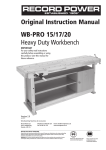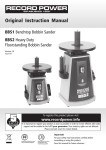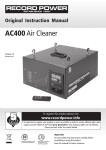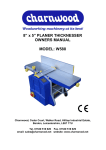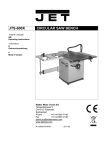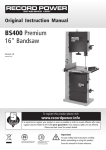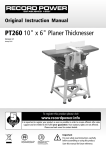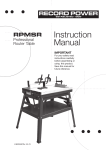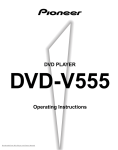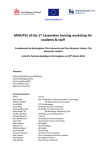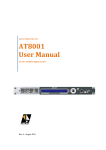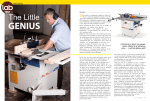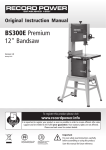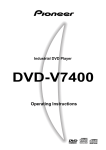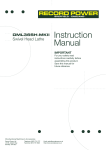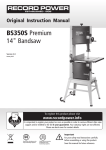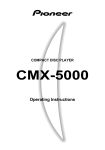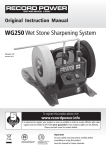Download TS200C Compact Cast Iron Table Saw
Transcript
Original Instruction Manual TS200C Compact Cast Iron Table Saw IMPORTANT For your safety read instructions carefully before assembling or using this product. Save this manual for future reference. Version 2.1 February 2010 Woodworking Machines & Accessories Record Power Ltd Unit B, Adelphi Way Staveley S43 3LS Telephone: 01246 561 520 Fax: 01246 561 537 Email: [email protected] www.recordpower.co.uk HEALTH AND SAFETY GUIDELINES Always follow the instructions provided with the manual. Always wear safety glasses when using woodworking equipment. Always disconnect the power before adjusting any equipment. Failure to observe proper safety procedures and guidelines can result in serious injury. WARNING: Do not allow familiarity (gained from frequent use of your machine and accessories) to become commonplace. Always remember that a careless fraction of a second is sufficient to inflict severe injury. Always wear safety glasses when using woodworking equipment. Always read the instructions provided before using woodworking equipment. Contents Terms & Conditions Of Usage Health & Safety Guidance page 3 Additional Safety Instructions For Table Saws page 4 Record Power Guarantee page 5 EU Declaration Of Conformity page 33 User Manual Consumable Spare Parts Quick Find 1. Identifying Shipping Boxes page 6 2. Getting To Know Your Table Saw page 7 3. Machine Specification page 7 4. Saw Unit Assembly page 8 5. Rip Fence Assembly page 15 6. Final Assembly page 17 7. Connection Of The Electricity Supply page 18 8. Operation & Sawing Practice page 19 9. Dust Extraction page 23 10. Maintenance page 24 11. Parts Diagrams page 26 12. Parts List page 26 Part Description Part Number Table insert Blade guard Blade guard extraction hose Riving knife Handwheel Fence extension Ratchet handle Fence lock knob Fence end gap Stop lock knob 93 1 2 86 78 191 188 206 176 148 Health & Safety Guidance READ ALL THE INSTRUCTIONS IN THIS MANUAL CAREFULLY BEFORE ASSEMBLY, INSTALLATION AND USE OF THIS PRODUCT. KEEP THESE INSTRUCTIONS IN A SAFE PLACE FOR FUTURE REFERENCE. WARNING: When using electric tools, basic safety precautions should always be followed to reduce the risk of fire, electric shock and personal injury. Safe Operation 1. Eye Protection The operation of any power tool can result in foreign objects being thrown into your eyes, which can result in severe eye damage. Always wear safety glasses or other suitable eye protection. Wear safety glasses at all times. Everyday glasses only have impact resistant lenses. They are not safety glasses which give additional lateral protection. It is also important to wear ear protectors when operating the table saw. 2. Keep work area clear. Cluttered areas and benches invite accidents and injuries. 15. Maintain tools with care. • Follow instructions for lubrication and changing accessories. • Inspect electric cords periodically and, if damaged, have them repaired by an authorized service facility or qualified electrician. • Inspect extension cords (if used) periodically and replace if damaged. Always use properly rated extension cord. 16. Disconnect Machine. When not in use, before servicing, changing blades etc. disconnect the machine from the power supply. 17. Never leave machine running unattended. Turn power off, do not leave machine until it comes to a complete stop. 18. Remove adjusting keys and wrenches. ENSURE that all adjusting wrenches and keys are removed before switching the machine ‘ON’. 19. Avoid unintentional starting. Ensure the switch is in the “STOP” position before turning on the power from the main electricity supply. Your Record Table saw already incorporates low voltage protection. This means the machine will not automatically start up after say a power cut, unless you first reset the start switch. 3. Consider work area environment. Do not expose the machine to rain or damp conditions. • Keep the work area well lit. • Do not use the machine in the presence of flammable liquids or gases. 20. Out-door Extension Leads. Your machine should not be used outdoors. 4. Guard against electric shock. Avoid body contact with earthed or grounded surfaces. 22. Check for damaged parts. • Before use of the machine, it should be carefully checked to determine that it will operate properly and perform its intended function. • Check for alignment of moving parts, binding of moving parts, breakage of parts, mounting and any other conditions that may affect its operation. • A guard or other part that is damaged should be properly repaired or replaced by a qualified person unless otherwise indicated in this instruction manual. Have defective switches replaced by a qualified person. • Do not use the machine if the switch does not turn on and off. 5. Keep other persons away (and pets). Do not let persons, especially children, not involved in the work, touch the machine, or extension cord (if used) and keep visitors away from the work area. 6. Store idle tools. When not in use, tools should be stored in a dry, locked- up place, out of reach of children. 7. Do not force the machine. It will do the job better and work more safely if operated at the speed at which it was intended. 8. Use the right tool. • Do not force small tools to do the job of a heavy-duty tool. • Do not use tools for purposes other than those for which they were intended. 9. Dress properly. • Non-slip footwear is recommended. • Do not wear loose clothing, neckties or jewellery; they can be caught in moving parts. • Roll up long sleeves above the elbow. • Wear protective hair covering to contain long hair. 10. Use protective equipment • Use safety glasses. (See note 1. above) • Use face or dust shield if cutting operation creates dust. • Use ear plugs or ear defenders when the machine is in use 11. Connect dust extraction equipment. (See section 9, page 22) 12. Do not abuse the cord. Never yank the cord to disconnect it from the socket. Keep the cord away from heat, oil and sharp edges. 13. Do not overreach. Keep proper footing and balance at all times. 14. Secure work. Ensure that your work piece is properly held before starting to cut. 21. Stay alert. Watch what you are doing, use common sense and do not use the machine when you are tired. 23. Warning! • The use of any accessory or attachment, other than those recommended in this instruction manual, or recommended by our Company may present a risk of personal injury. 24. Have your machine repaired by a qualified person. • This electric machine complies with the relevant safety rules. Only qualified persons using original spare parts should carry out repairs. Failure to do this may result in considerable danger to the user. 25. This machine is designed for cutting wood. • Do not use for cutting any material other than wood. Maintenance and Servicing This machine requires very little maintenance. This handbook gives clear instructions on installation, set up and operation. Read these instructions carefully. Remember always to switch off and unplug from the main electricity supply before carrying out any setting up or maintenance operations. Should you need advice on the repair or maintenance of this product, our Customer Service Department can be contacted on 01246 561 520 and will be happy to assist you. Record Power Health & Safety Guidance v1.0 2 3 Additional Safety Instructions for Table Saws SAFETY IS A COMBINATION OF OPERATOR COMMON SENSE AND ALERTNESS AT ALL TIMES WHEN THE TABLE SAW IS BEING USED. WARNING: FOR YOUR OWN SAFETY, DO NOT ATTEMPT TO OPERATE YOUR TABLE SAW UNTIL IT IS COMPLETELY ASSEMBLED AND INSTALLED ACCORDING TO THE INSTRUCTIONS. SAFE OPERATION 1. The table saw should be bolted to the floor where possible. 2. If you are not thoroughly familiar with the operation of table saws, obtain advice from your supervisor, instructor, or other qualified person or contact your retailer for information on training courses. Do not use this machine until adequate training has been undertaken. 3. Never turn the machine ‘ON’ before clearing the table of all objects (tools, scrap pieces etc.) 4. Ensure that: (i) the voltage of the machine corresponds to the mains voltage. (ii) To use an earthed power source (wall socket). (iii) The cord and plug are in good condition, i.e. not frayed or damaged. (iv) No saw teeth are missing and the blade is not cracked or split. Otherwise replace blade. (v) The blade is aligned. 5. Never start the machine with the saw blade pressed against the workpiece. 6. Never apply sideways pressure on the blade. 7. Care must be taken when cutting wood with knots, nails or cracks in it and / or dirt on it. 8. Never leave the machine running unattended. 9. Do not use saw blades which are damaged or deformed. 10. Ensure the selection of the saw blade is suitable for the material to be cut. 11. If the electrics are damaged, parts must only be replaced by a qualified electrician. 12. Never use a long extension cable. 13. Always use a push stick and keep hands clear of the blade. 14. Never remove the crown guard or riving knife. These are there to protect the user. 15. WARNING LABELS – It is important that labels bearing Health & Safety Warnings are not removed or painted over. New labels are available from Customer Services. 16. MECHANICAL SAFETY – The security of all clamps and work holding devices should be checked before switching on. 17. WOOD DUST – The fine particles of dust produced in cutting operations are a potential health risk. Some imported hardwoods do give off highly irritant dust which causes a burning sensation. We strongly recommend the use of a dust collector and dust mask/visor. Our Customer Services Department will also be happy to advise you on the correct unit for your needs. 18. This machine falls under the scope of the ‘Health & Safety at Work etc. Act 1974’, and the ‘Provision & Use of Work Equipment Regulations 1998’. We recommend that you study and follow these regulations. For further help on any of the above matters please contact our Customer Services Department at :Tel: 01246 561 520 Fax: 01246 561 536 WARNING: Do not allow familiarity (gained from frequent use of your machine) to cause complacency. Always remember that a careless fraction of a second is sufficient to inflict severe injury. Record Power Guarantee 1. INTRODUCTION 1.1 We supply machinery through a network of dealers and authorised distributors and you should be aware that your contract of sale is with the retailer from whom you purchased this product. 1.2 If you are not satisfied with this product you should in the first instance approach the retailer from whom you purchased it. 1.3 Customers have statutory rights to protect them and information on this can be found at the Citizens Advice Bureau or on such web-sites as that operated by the DTI (http://www.dti.gov.uk) 1.4 Returning your guarantee card will speed up the claims procedure and can be very helpful as a proof of purchase should the initial receipt be mislaid or damaged. We recommend that this is returned as close to your original purchase date as possible. 1.5 Correct installation, set-up, adjustment and routine maintenance of the machine are the responsibility of the end-user and problems arising from incorrect set-up, adjustment or maintenance are not covered by the terms of this guarantee. However support is available in the first instance from the retailer who supplied you and free technical support is available from Record Power on 01246 561 520 during office hours and from an extensive knowledge base on our website www.recordpower.co.uk. We also recommend that those users who have not had suitable training in the safe use of machinery should seek such training locally before using or attempting to set up and adjust any machinery (please contact your retailer for recommendations in your local area). 2. GUARANTEE 2.1 In addition to the above Record Power guarantees that for a period of 5 years from the date of purchase the components of this product will be free from defects caused by faulty construction or manufacture. 2.2 During this period Record Power will repair or replace free of charge any parts which are proved to be faulty in accordance with paragraph 2.1 above provided that: 2.2.1 You follow the claims procedure set out below; 2.2.2 We are given a reasonable opportunity after receiving notice of the claim to examine the product. 2.2.3 If asked to do so by us, you return the product to Record Power's premises or other approved premises such as those of the supplying dealer, for the examination to take place. 2.2.4 The fault in question is not caused by continuous industrial use, accidental damage, fair wear and tear, wilful damage, negligence on your part, incorrect electrical connection, unapproved modification, abnormal working conditions, failure to follow our instructions, misuse, or alteration or repair of the product without our approval. 2.2.5 This product has been purchased by you and not used for hire purposes; 2.2.6 This Guarantee extends to the cost of carriage incurred by you returning the product to Record Power as long as it is demonstrated that the defect falls within the terms of this Guarantee and you follow the claims procedure as outlined below; address below on the last day of this Guarantee at the latest. Late claims will not be considered. 3.4 We will contact you once we have received your initial written claim. If it is necessary to return the item, in most cases but subject always to clause 2.2.5, we will arrange for collection or will provide freepost information to enable return depending on the weight and size of the product concerned. If the product is to be returned to us, we will agree with you in advance a Returns Number, to speed tracking of the claim and ensure the most appropriate method of return to you is used. 4. NOTICE This Guarantee applies to all goods purchased from an authorised retailer of Record Power within the United Kingdom of Great Britain and Northern Ireland. This Guarantee does not confer any rights other than those expressly set out above and does not cover any claims for consequential loss or damage. This Guarantee is offered as an extra benefit and does not affect your statutory rights as a consumer. Additional written copies of this Guarantee can be obtained by writing to the address below. Please include a stamped and self addressed envelope for each copy of the Guarantee requested. Record Power Ltd. Unit B, Adelphi Way Ireland Industrial Estate Staveley, Chesterfield S43 3LS 3. CLAIMS PROCEDURE 3.1 In the first instance please contact the retailer who supplied the product to you. In our experience many initial problems with machines that are thought to be due to faulty parts are actually solved by correct setting up or adjustment of the machines. A good dealer should be able to resolve the majority of these issues much more quickly than processing a claim under the guarantee. 3.2 If the dealer who supplied the product to you has been unable to satisfy your query, any claim made under this Guarantee should be made directly to Record Power at the address set out at the foot of this Guarantee. The claim itself should be made in a letter setting out the date and place of purchase, and giving a brief explanation of the problem which has led to the claim. This letter should then be sent with proof of the purchase date (preferably a receipt) to Record Power. If you include a phone number or email address this will help to speed up your claim. 3.3 PLEASE NOTE that it is essential that the letter of claim reaches the Record Power Guarantee v1.0 4 5 1. Identifying Shipping Boxes BEFORE ASSEMBLY It is advisable that before unpacking to have plenty of paper towels or cloths available to clean off the rust preservative. Contents of the shipment: 1. TS200C Table Saw 2. Sliding Table 3. Wheel kit (optional accessory) 4. Right hand extension table (optional accessory) 1 2 3 4 2. Getting To Know Your Table Saw A C D B I E M N J G F K Shown with sliding table and wheel kit A Extraction Hose G Switch Unit B Blade I Extension Table C Crown Guard J Blade Tilt D Rip Fence K Cabinet Base E Main Table M Sliding Table F Blade Raise & fall N Cross Cut Fence 3. Machine Specification TS200C SPECIFICATION Blade size: 250mm Blade bore: 30mm Blade speed: 4000rpm Max width (blade to fence) : 600mm Table Height : 890mm Max depth of cut using 250mm blade: 80mm @ 90º / 56mm @ 45º Extraction ports: 30mm upper, 100mm lower Motor power (output): 2hp Weight: 110kg Dimensions not including the sliding carriage: 900mm (height) x 625mm (width) x 675mm (length) Dimensions of sliding beam: 1050mm (length) x 215mm (width) Sliding carriage stroke / max sheet capacity: 620mm Recommended length of workshop space, full stroke at sheet capacity: 1620mm (approx.) 6 7 4. Saw Unit Assembly CAUTION Many of the items are very heavy. We recommend that assistance is sought before trying to lift the larger components. 1 4.1 Identification of saw unit components 3 2 1. 2 x Long mid brace supports 2. 2 x Short mid brace support 3. 2 x Long top brace supports 4. 2 x Short top brace supports 5. 4 x Legs 6. 1 x Saw unit 7. 1 x Sliding table 8. 1 x Mitre fence seat 9. 1 x Mitre fence 10. 1x Connector 1 11. 1 x Jubilee clip 12. 1 x Extraction port 13. 1 x Mains cord 14. 1 x Push stick 15. 1 x Crown guard 16. 1 x Aluminum fence & fence carrier 17. 1 x Rip fence scale & extrusion 18. 1 x Extraction hose support w/mounting parts 19. 1 x Front fence bar 20. 1 x Rear rail 21. 2 x Handwheel 22. 1 x Extraction hose 23. 1x Workpiece block 24. 1x Loose bag 1 25. 1x Loose bag 2 4 5 6 7 24 25 9 18 17 10 13 14 15 21 8 22 11 12 20 16 18 23 4. Saw Unit Assembly - cont. CAUTION Many of the items are very heavy. We recommend that assistance is sought before trying to lift the larger components. Fig.4.1 Fig.4.4 Note: When assembling this table saw, Do not fully tighten the nuts and bolts until the assembly is complete. 4.2 Stand Assembly 1. Locate the first leg and secure it to one of the long top brace supports using the nuts, bolts and washers supplied Fig.4.1 and Fig.4.1B. 2. In the same way, attach the second leg to the brace support Fig.4.2. 3. Locate the short top brace supports and fix the to the legs as shown Fig.4.3. Fig.4.1B Fig.4.5 Fig.4.2 L O N G M I D B R AC E SUPPORT 4. Continue in this way until all of the legs and top brace supports have been fitted Fig.4.4. 5. Locating holes a third of the way down each leg are for securing the mid brace supports. Fix the long mid brace supports to the frame using the nuts, bolts and washers Fig.4.5. LONG TOP BRACE SUPPORT 6. Finally, fit the short mid brace support to one of the shorter sides Fig.4.6. Note The side without the short mid brace support fitted will be referred to as the front of the stand. This leaves the front area free for wheel kit operation. Fig.4.6 Fig.4.3 SHORT TOP BRACE SUPPORTS FRONT 8 9 4. Saw Unit Assembly - cont. 4.3 Fitting the optional wheel kit 1. On the underside of the operating frame, find the two raised areas on either side. Mount the two back wheels and secure in place using the nuts and bolts provided Fig.4.7A. Fig.4.7A 2. With the operating frame in hand, locate the release pedal and fix it to the operating frame Fig.4.7B. Fig.4.7F RAISED AREAS PIN & WASHER 3. Take the two front wheels and mount and secure them to the operating frame pedal Fig.4.7C. Now slide an axle through on one of the front legs and hook a brace support bar on it. Place a washer on and slide a pin throughout the axle end Fig.4.7D. 4. Pass the axle through the operating frame pedal and through the opposing legFig.4.7E. Once the axle is through the opposing leg hook the remaining brace support bar on the axle and secure with a washer and pin as previous Fig.4.7F. Fig.4.7G Fig.4.7B RELEASE PEDAL 5. Now pass the remaining axle through the rear of the stand and hook the brace support bar with washer and pin as previous. Fig.4.7G. 6. The operating frame can now be fitted to the axle and secured to the opposing rear leg with the other brace support bar, washer and pin. Ensure when this operating frame is fitted that it sits below the operating frame pedal Fig.4.7H. Fig.4.7C 7. Once the frame is upright, the whole assembly should fall into place. However it will not operate correctly until the actual table saw is fitted. Fig.4.7I. Fig.4.7H 4.4 Fitting the saw to the base CAUTION This saw unit is very heavy. It is advisable to seek assistance before attempting to lift it onto the base. Lift the saw onto the assembled open stand and secure in place with the four hex bolts from underneath the open stand. Fig.4.7D AXLE PIN WASHER BRACE SUPPORT BAR Fig.4.8 Fig.4.7E Hex. head bolts Fig.4.7I BRACE SUPPORT BAR 4. Saw Unit Assembly - cont. 4.5 Fitting the handwheel Attached the handwheel for blade tilt and rise & fall with Hex. wrench. Fig.4.9A Fig.4.9A 4.6 Fitting the extraction hose 1. Unfasten the dust extraction hose from underneath the main saw unit and thread through the extraction hole in the side on the machine Fig.4.9B. 2. Fit the extraction port over the end of the hose and clip into place Fig.4.10. 3. Secure the extraction connector to the end of the hose using the jubilee clip Fig.4.11. Fig.4.9B Fig.4.10 Extraction port Fig.4.11 4.7 Fitting the sliding table 1. Before fitting the sliding table onto the table saw. Check if the saw blade is square to the table. Jubilee clip 2. Wind the blade up through the table slot . Check if the blade is parallel with the table slot and make sure that the gap shown is minumum 3mm. Fig.4.12 Extractor connector 3. If the table is out of parallel with the blade, loosen the four Allen bolts to move the table for correction. Fig.4.13. Fig.4.12 Fig.4.13A Allen bolts and washers 10 11 4. Saw Unit Assembly - cont. 4.8 Adjusting the sliding table The Sliding table is pre-adjusted in the factory. If it is out of parallel or not sliding smoothly, you can make adjustments according to the instructions below. Fig.4.14 1.Checking the Height Put the straight gauge on the sliding table and cast table to check if the sliding table is the same height as the main table (Fig 4.13). If it is not, you can adjust the four guide wheels to correct. Two of them can only adjust vertically. The other two are eccentric wheels and can adjust both vertically and horizontally (Fig 4.15). 2. To adjust the height of the two inside wheels. Adjust the height of the guide wheels to the correct position with a screwdriver and a wrench(Fig. 4.16). Fig.4.15 Fig.4.16 For vertical adjustment For vertical and horizontal adjustment 3. To adjust the height of the outside wheels, loosen the nut at the end of wheel shaft with a screwdriver and a wrench through the adjusting window. Then adjust the self-lock nut to achive the correct height with a wrench.(Fig. 4.17) 4. When the tables are at the correct height, check the sliding table to see if it moves smoothly. If not, loosen the bottom lock nut through the window (Fig. 4.17) and using a screwdriver rotate the eccentric wheels to correct. (Fig. 4.18) Fig.4.18 Fig.4.17 Self lock nut 4. Saw Unit Assembly - cont. 4.8 Fitting the optional right table extension If you are fitting the optional table extension please proceed as below. 1. Take the 4 hex head bolts and washers, wind them into the location holes on right side of the main table leaving a gap of approximately 10mm between washer and table Fig.4.21. Fig.4.21 Fig.4.25A Approx. 10mm 2. Hook the table extension onto the bolts that have just been attached to the main table Fig.4.22A and Fig.4.22B. Tighten the mounting bolts to secure the table, but leave enough slack so the table can be adjusted. 3. Taking a suitable straight edge, check the level of the extension table to the main table Fig.4.23. To adjust the table; first lift the table extension so it sits slightly proud of the main table and tighten the hex head bolts the table is hooked on to Fig.4.22A. Fig.4.22A Fig.4.25B 4. To flatten the table, take a mallet and a flat wooden block and tap down on the extension table Fig.4.25A until level with the main table Fig.4.25B. When tapping the block strike as close to the seam between the tables as possible. TIP The success of the table levelling procedure largely depends on the adjustment of the mounting bolts. The smaller the movement required, the tighter the bolts should be. However, the whole procedure really does depend on feel. If the table isn't moving enough when tapped, slacken the bolts slightly. If it is moving too much tighten them. Table hooked on to the bolts Fig.4.22B TIP Level one end at a time, when one end of the table is level tighten that bolt to lock this in position before setting the other end. If the table has moved too low raise back up above the main table and restart the procedure. 5. When you are satisfied that the tables are level perform one last check along the length of the tables with the straight edge Fig.4.23 and fully tighten the mounting bolts. Fig.4.23 12 13 4. Saw Unit Assembly - cont. 4.9 Fitting the crown guard Hook the crown guard into the keyway on top of the riving knife Fig.4.28 and tighten into position Fig.4.29. Fig.4.28 Fig.4.29 5. Rip Fence Assembly 9 5.1 Identification of rip fence components 1. 4 x Hex. nuts 2. 8 x Washers 3. 1 x Front fence bar 4. 2 x Hex. socket screws 5. 2 x Hex. bolts, washers(4) & hex. nuts (each) 6. 1 x Rear rail 7. 1 x Aluminum fence 8. 1 x Fence carrier 9. 1 x Extraction hose support 10. 1 x 'U' Piece 11. 2 x Pan head screw, hex. nuts (each) 10 11 1 2 3 4 5 6 8 7 5.2 Fixing the fence bar Locate fence bar onto the table Fig.5.1A and fix with the two fence fixing bar nuts and washers (four fence fixing bar nuts and washers for optional table extension bar). With those nuts and washers in place on the other side of the table Fig.5.1B Secure the fixing Fig.5.2A but do not fully tighten yet as they may need to be adjusted later in the setup process. Fig.5.1B Fig.5.2A 5.3 Fixing the fence scale Locate fence scale onto the table Fig. 5.2B and fix with two pan head screws (four pan head screws for optional table extension fence scale). Fig.5.1A FIXING NUTS & WASHERS Fig.5.2B FENCE BAR 14 15 5. Rip Fence Assembly - cont. 5.3 Fitting the fence carrier Fasten the fence holding fixtures through the fence carrier casting Fig.5.3. Locate the fence carrier on to the fence rail Fig. 5.4 5.4 Fitting the rip fence Now simply slide the rip fence on to the fence carrier and tighten the holding fixtures. Screw in the lock knob to secure the position of the fence on the rail Fig 5.6. The fence can be used in the upright position as shown or the fence can be attached to the carrier using the other "T" slot giving another position. 5.5 Fence alignment 1 Align the fence assembly in or out until parallel with the side of the blade by turning the adjustment nuts and the fence bolts accordingly. If the fixing nuts have been tightened, these will need slackening off before this adjustment can be made. Fig.5.3 HOLDING FIXTURES FENCE CARRIER Fig.5.4 FENCE ADJUSTMENT NUT FENCE RAIL MOVEMENT Fig.5.5 FENCE RAIL 5.6 Fence alignment 2 Check that the fence is 90 degrees to the table using a suitable square. If no adjustment is needed fully tighten the fence bar nuts. If adjustment is required this is achieved by raising or lowering either side of the fence rail until the fence itself is 90 degree to the table. Once set at 90 degree fully tighten the fence bar nuts. T-SLOT FENCE RAIL Fig.5.6 FENCE ADJUSTMENT FENCE RAIL 5.7 Fitting the rear fence railLocate rear fence rail onto the table Fig. 5.6. and fix with two hex. socket screws for the main table and two hex. bolt, washers and nuts for the table extension. 6. Final Assembly Fitting crown guard extraction hose 1. Fit the hose support in the U-piece that has been fitted in the rear main table or optional table extension. Fig.6.1. 2. Now attach one end of the hose to the crown guard Fig.6.2 Fig.6.1 Hose support 3. Hook the hose over the hose support and feed underneath the table to connect with the main extraction outlet Fig.6.3 U-piece Fig.6.2 Fig.6.3 Main extraction outlet 16 17 7. Connection Of The Electricity Supply Once the machine has been correctly assembled and set up the electricity supply can be connected. Connect the two pin plug socket on the end of the flex to the switch Fig.7.1. The machine can only be connected to a single phase supply. Before connecting the electrical supply ensure that it is the correct voltage, phase and frequency, and that it has sufficient capacity for the machine. The relevant information can be found on the rating plate located on the rear of the machine. Machines supplied for use in the UK are fitted with a BS1363 plug fitted with a 13 amp fuse. Ensure that you use the appropriate plug for use in other countries. If the plug fitted to the machine is changed for any reason, the wires in the mains lead are coloured in accordance with the following code: Green and yellow: Blue: Brown: Earth Neutral Live As the colours of the wires in the mains lead may not correspond with the coloured markings identifying the terminals on your plug, proceed as follows: The wire coloured green and yellow must be connected to the terminal marked ‘E’ or by the earth symbol ~ or coloured green; or green and yellow. The wire coloured blue must be connected to the terminal marked ‘N’ coloured black. The wire coloured brown must be connected to the terminal marked ‘L’ or coloured red. IT IS IMPORTANT THAT THE MACHINE IS EFFECTIVELY EARTHED. If in doubt about the connection of the electrical supply consult a qualified electrician. RCD (Residual Current Device) For your additional safety we always recommend the use of an RCD (sometimes called Residual Current Circuit Breaker or Earth Leakage Circuit Breaker). Fig.7.1 8. Operation & Sawing Practice Basic circular saw principles • The blade rotates on a spindle, and breaks through the timber, cutting on a continuous stroke Fig.8.1. Fig.8.1 • Slowly feed the workpiece towards the blade Fig.8.1, let the blade do the cutting it is not necessary to force the material. When feeding towards the blade hold the workpiece firmly and use the table to provide support. Always use a push stick, keeping your hand well away from the blade. • For best results the blade must be sharp and in good condition. A damaged or worn blade should always be replaced. • Select the right blade for the job, depending on the type of material and the cut to be made see table 2 (page 31). TABLE 1: Basic applications RIPPING When the timber is cut with the grain, use the rip fence for this application CROSS CUTTING When the timber is cut across the grain, use either mitre fence or sliding carriage for this application PANEL SIZING Dimensioning man made sheet material. Use either the rip fence or sliding carriage for this application BEVELLED EDGE When a bevelled (angled) edge is required to the workpiece tilt the blade and pass the timber though. If the rip fence is being used with the blade is tilted the auxiliary fence should be used in the low position to prevent it fouling on the blade when tilted. 18 19 8. Operation & Sawing Practice - cont. Blade selection Before undertaking any application on a table saw is important to consider blade selection. There are many blade types available and it is important to select the right blade for the job. The TS200C is supplied with a good multipurpose blade, but for specialist applications a blade with a different tooth pattern may be required. Fig.8.2 Fig.8.3 A table saw can be fitted with two different styles of blade: An alternative bevel blade Fig.8.2 or a triple chip tooth blade Fig.8.3. See table 2 for applications TABLE 2: Blade selection BLADE TYPE APPLICATION 24 TOOTH Ideal for deep ripping softwoods ALTERNATE BEVEL POSITIVE HOOK 30 TOOTH Ideal for deep ripping hardwoods ALTERNATE BEVEL POSITIVE HOOK 36 TOOTH ALTERNATE BEVEL POSITIVE HOOK General purpose, suitable for ripping and cross cutting both soft and hardwoods. 40 TOOTH Suitable for cross cutting both soft and hardwoods. ALTERNATE BEVEL POSITIVE HOOK 40 TOOTH ANTI KICKBACK ALTERNATE BEVEL SEMI-POSITIVE HOOK 80 TOOTH ALTERNATE BEVEL POSITIVE HOOK 80 TOOTH Suitable for cross cutting both soft and hardwoods, provides protection from kickback. Suitable for cross cutting and gives a fine finish on man-made sheet material and laminates Suitable for cross and cutting gives a fine finish on man-made sheet material and laminates. Triple chip teeth reduce breakout on the material. TRIPLE CHIP POSITIVE HOOK When choosing a blade for a table saw always ensure that it is a hard bodied blade, soft bodied blades are only suitable for power tools. The easiest way to tell the difference between hard and soft bodied blades is that hard bodied blades have movement slots cut into the gullets of the blade Fig.8.4, where as soft bodied blades are solid Fig.8.5. Blade maintenance It is essential that whichever blade is selected that it is in good condition. Any build up of timber resin near the teeth of the blade will cause the workpiece to stall or stick. These deposits should removed with white spirit after cleaning it is also advisable to coat the blade with silicone spray. Do not use any product which contains oil on the blade as this will attract dirt. Never try to clean a moving blade. The saw should be stopped, the blade removed and the resin removed with a proper scraper. Fig.8.4 HARD BODIED Suitable for table saws Fig.8.5 SOFT BODIED Unsuitable for table saws 8. Operation & Sawing Practice - cont. Workpiece Support Good workpiece support is essential on a table saw. Additional supports should always be used if the workpiece overhangs the table. Roller stands are ideal for this purpose and should be used at both infeed and outfeed ends of the machine. A rip fence, cross cut fence or mitre fence should be used to support the workpiece during the cutting action Fig 8.6A, B & C. Fig.8.6A Fig.8.6B During angled or shallow work the auxiliary fence should be re-fitted into the low position to aid the use of a push stick and to stop the blade fouling on the fence Fig 8.7A & B. Use Of A Push Stick A push stick should always be used when making any cut less than 300mm in length or when feeding the last 300mm of a longer cut. the leading hand should never be closer than is necessary to the front of the saw and hands should never be in line with the saw blade. A push-stick should always be used to remove the cut piece from between the saw blade and fence. Fig.8.6C Fig.8.6A Setting The Saw Guard The saw guard should be adjusted as close to the workpiece as possible Fig 8.8. Setting The Rise & Fall The rise and fall must be adjusted so the saw guard is as close to the workpiece as possible. However the teeth should project through the top of the workpiece at all times. Fig 8.8. The rise and fall is operated using the large handwheel on the front of the machine Fig 8.9. Setting The blade tilt To tilt the blade in order to achieve a bevelled edge unlock the lock knob and turn the small handwheel until blade is positioned as required Fig 8.9. Fig.8.7B Fig.8.8 Fig.8.9 Rise & fall Blade tilt 20 21 9. Operation & Sawing Practice - cont. Kickback Kickback can occur as the material passes through the saw blade. When the timber is past the centre point on the blade the teeth are moving upwards and towards the user Fig.9.12. If the timber closes onto these upward moving teeth the timber will kickback. The way to overcome kickback is to prevent the timber from closing up onto the blade. To prevent this from happening the fence must be set correctly, if the auxiliary fence is set too far along it can force the timber into the blade and cause kickback Fig.9.13. By setting the auxiliary fence in front of the blade centre Fig.9.14. the timber has space to move into as the cut is made. Kickback is now far less likely occur as the timber isn't being forced into the upward moving blade. Pull saw The TS200C features a pull saw function which is ideal for cross cutting small workpieces, accurate repetitive cuts can easily and safely be achieved. Fig.9.15 Fig.9.12 Centre point of the blade Positive angle stop screw Workpiece Fig.9.13 Fig.9.16 Riving knife -45º Positive angle stop screw Auxiliary fence Slide lock knob Angle lock handle Positive angle catch 00º Positive angle stop screw +45º Positive angle stop screw The first aspect which should be understood is the mitre fence hold down clamp. Fig.9.15 Fig.9.17. Blade centre point Fig.9.17 Positive angle catch Fig.9.14 Riving knife Auxiliary fence Blade centre point Positive angle stop screw 10. Dust Extraction 10.1 The importance of dust extraction Before the machine is started, ensure that adequate dust extraction provisions have been installed. Dust extraction is extremely important not only for health and safety but also for the correct upkeep of the machine. Saw dust can cause the machine not to operate properly or even fail completely. It is paramount that the extraction port is kept free of waste so mounds of sawdust do not build up around the lower band wheel and blade guides. It is advisable before starting the machine to inspect the internals of the machine and ensure there isn’t excessive dust build up. By keeping the machine free of large amounts of waste the performance will be enhanced. Even with adequate extraction there will be partial build up of dust inside the machine, this should be cleaned out as part of the regular maintenance schedule. If a large amounts of MDF or toxic woods are to be cut we recommend that there is a good ventilation system in place and that a P2 particle mask is worn as minimum protection. RSDE3 High Filtration Dust Extractor Bag type extractor, 80 litre capacity, single 1kw motor, suitable for intermittent use i.e must be switched off for 20 minutes per hour. DX4000 High Filtration Dust Extractor Drum type extractor, 80 litre capacity, Twin 1kw motor, suitable for heavy usage i.e if one motor is switched off for 20 minutes then the other can be used thus enabling continuous usage. Or both motors can be used simultaneously giving maximum suction but in this mode the extractor must be switched off for 20 minutes every hour. DX5000 High Filtration Dust Extractor Bag type extractor, 200 litre capacity, Twin 1kw motor, suitable for heavy usage i.e if one motor is switched off for 20 minutes then the other can be used thus enabling continuous usage. Or both motors can be used simultaneously giving maximum suction but in this mode the extractor must be switched off for 20 minutes every hour. 10.2 Record Power Extractors Record Power offer a range of high quality dust extractors, starting at the single motor 45 litre RSDE1 right up to the 200 litre twin motor DX5000. We offer both drum and bag type extractors and all models provide high filtration down 0.5 micron providing protection from harmful fine dusts such as MDF. RSDE1 High Filtration Dust Extractor Drum type extractor, 45 litre capacity, single 1kw motor, suitable for intermittent use i.e must be switched off for 20 minutes per hour. RSDE2 High Filtration Dust Extractor Drum type extractor, 50 litre capacity, single 1kw motor, suitable for intermittent use i.e must be switched off for 20 minutes per hour. RSDE1 Bandsaws Circular saws Sanders Intermittent usage RSDE2 3 Recommended 3 Recommended RSDE3 DX4000 3 Recommended Bandsaws Circular saws Sanders Heavy usage Planer Thicknessers Spindle Moulders Universals Intermittent usage Dust Extraction System Intermittent usage Recommended 3 Recommended 3 Can be used Planer Thicknessers Spindle Moulders Universals Heavy usage 3 3 Can be used 3 Can be used 3 Can be used DX5000 CX2000 CX2600 3 Recommended 3 Recommended 3 Recommended 3 Recommended 3 Recommended 3 Recommended 3 Recommended 3 Recommended 3 Recommended 22 23 11. Maintenance Changing the blade 1. To change the blade; first remove the crown guard by slackening off the locking screw and unhooking from the riving knife Fig.11.1. Fig.11.1 Fig.11.5 2. Loosen the 3 screws on the table insert Fig.113 and remove the insert. 3. Remove the sliding table stop and remove the sliding table Fig.11.2A/11.2B to give access to the extraction panel. Loosen the holding screw on the extraction panel and pull the panel away from the blade to create a space between them Fig.11.5. 4. Place the tommy bar in the location hole behind the blade Fig.11.7. Locking screw Fig.11.2A Fig.11.6 Fig.11.2B Fig.11.7 5. Using a spanner, turn the nut clockwise to loosen it. At this point the tommy bar should have turned with the blade and be tight up against the spindle housing creating an anchor to turn against Fig.11.4. 6. Remove the nut, washer and bush from the blade spindle Fig.11.6. NOTE Take care not to drop the nut down into the unit. 7. It is now possible to remove the blade from the spindle Fig.11.7. The blade can now be replaced. 8. Feed the new blade on to the spindle ensuring that it is seated firmly on the hub. 9. Replace the bush, washer and nut and using a spanner, turn the nut anti-clockwise to tighten it. At this point the tommy bar should have turned with the blade and be tight up against the spindle housing to create an anchor to turn against. 10. Replace the table insert and retighten the screws to hold it in place. Fig.11.3 11. Re-fit the sliding table and secure by fitting the sliding table stop. Fig.11.4 11. Maintenance - cont. NOTE To adjust the belt tension of the, motor it may be necessary to remove the tables to access the inside of the saw unit. Fig.11.10A Fig.11.13 Bolt 1 Tensioning the belt 1. When tensioning the belt the three motor mounting bolts must be slackened Fig.11.10A and Fig.11.10B. 2. Slacken the three bolts and pivot the motor to the right to increase tension Fig.11.13. When desired tension is achieved, retighten the three bolts to secure the setting. Bolt 2 Fig.11.10B Bolt 3 24 25 12. Parts Diagrams 12. Parts Diagrams - cont. 26 27 12. Parts Diagrams - cont. 12. Parts Diagrams - cont. 28 29 12. Parts Diagrams - cont. 13. Parts List Ref No. Description Ref No. Description 1 2 3 4 5 6 7 8 9 10 11 12 13 14 15 16 17 18 19 20 21 22 23 24 25 26 27 28 29 30 31 32 33 34 35 36 37 38 39 40 41 42 43 44 45 46 47 48 49 50 51 52 53 54 55 56 Blade guard assembly Dust collecting tube Blade Mount adjusting base Mount base Lock handle assembly Flat washer 8 Rotating support base Mount base Shaft Rubber washer Adjusting washer Bearing 80103C Retaining ring Big quill tube Shaft pulley Quill tube Bearing 80301C Adjusting wheel Hex. Nut M8 Big washer Flat washer 8 Multi-belt Hex. Bolt M6X20 Flat washer 6 Flat washer 6 Angle shaft Hex. Nut M8 Flat washer 8 Tube Washer Retaining ring Screw shaft Screw tube Tube Position screw Washer Dust collector Hex. Bolt Hex. Nut M10X1.5 Flat washer Blade collar Circlip 32mm Washer Screw M6X20 Hex. Nut M6 Flat washer 6 Hex. Nut M8 Flat washer 8 Tube Quill tube II Position bolt Hex. Nut M6 Lock nut M6 Screw M6X35 Pessure plate 57 58 59 60 61 62 63 64 65 66 67 68 69 70 71 72 73 74 75 76 77 78 79 80 81 82 83 84 85 86 87 88 89 90 91 92 93 94 95 96 97 98 99 100 101 102 103 104 105 106 107 108 109 110 111 112 Tube Quill tube I Screw M8X20 square nut Flat washer Spring washer 8 Angle rotating shaft Tube circlip Dust collecting tube Motor Motor pulley Washer Big washer Hex bolt Motor mounting plate Gear rod Circlip 12mm Circlip 22mm Bearing Bearing base Screw Big handwheel Wheel handle Screw Screw Rod Hex socket head screw M6X10 Mount, riving knife Guide plate assembly Guide plate Direction washer Pressure plate Flat washer 10 Hex nut M10 Spring washer 10 Main table Table insert Screw M5X8 Table, right side Hex. Bolt M8X12 Flat washer 8 Hex. Nut M5 Flat washer 5 Support bracket Semicircular bracket Pan head screw M5X10 Staff guage Pan head screw M6X16 Hex socket head screw M8X16 Rear rail Screw M4X8 Flat washer 4 Front panel Cabinet Assembly Switch Screw M4X60 13. Parts List - cont. Ref No. Description Ref No. Description 113 114 115 116 117 118 119 120 121 122 123 124 125 126 127 128 129 130 131 132 133 134 135 136 137 138 139 140 141 142 143 144 145 146 147 148 149 150 151 152 153 154 155 156 157 158 159 160 161 162 163 164 165 166 167 168 Tapping screw ST4.2X9.5 Carrier cover Carriage bolt M8X16 Flat washer 8 Spring washer 8 Pan head nut M8 Hex bolt M6X16 Flat washer 6 square nut Cover, fence knob Body, fence knob Bracket Tube Eccentric adjuster Flat washer 8 Spring washer 8 Hex. Nut M8 Support, sliding wheel Base, sliding table Sliding table Safety switch Hex. Bolt M4X30 Hex. Nut M4 Flat washer 4 Pan head screw M4X10 Shield bracket Bracket Countersunk head screw M6X16 Position pin Hex. Nut M12X1.5 Spring Pin roll 3x16 Position collar shaft Hex. Nut M6 Handle knob Carriage bolt M8X16 Flat washer 8 Hex. Nut 8 Front brace Shelf beam Support leg Rubber foot Side beam Side brace Push bracket Rotate Wheel Support bracket Spring bracket Hex. Bolt M8X20 Flat washer 8 Hex. Nut M8 Wheel Roll pin 3x35 Flat washer 10 Shaft 169 170 171 172 173 174 175 176 177 178 179 180 181 182 183 184 185 186 187 188 189 190 191 192 193 194 195 196 197 198 199 200 201 202 203 204 205 206 Position bracket Fence Carriage bolt M6X30 T bracket Mitre gauge Countersunk head screw M6X70 Nut Right end cap Tapping screw ST4.2X9.5 Left end cap Countersunk head screw M6X50 Flat washer 6 Flat washer 6 Flat washer 4 Screw M4X12 Indicator base Roll pin Indicator Screw M4X8 Adjusting handle Hex. Nut M4 Screw M4X16 Fence, "L" shape Carriage bolt M6X35 Fence support brace Flat Washer 6 Nut Fence base Micro-adjusting base Front rail Hex socket head screw M8X45 Support shaft Hex. Nut M8 Flat washer 8 Micro-adjusting knob Flat washer 6 Hex. Nut M6 Lock handle 46 47 EU Declaration of Conformity Cert No: EU / TS200C / 1 RECORD POWER LIMITED, Unit B, Ireland Industrial Est. Adelphi Way, Staveley, Chesterfield S43 3LS declares that the machinery described: 1. 2. 3. Type: Table Saw Model No: TS200C Serial No ......................................................................... Conforms with the following directives: MACHINERY DIRECTIVE 2006/42/EC LOW VOLTAGE DIRECTIVE 2006/95/EC ELECTROMAGNETIC 2004/108/EC COMPATIBILITY DIRECTIVE EN 55014-1:2006 EN 61000-3-2:2006 EN 61000-3-3:1995+A1+A2 EN 55014-2:1997+A1 and conforms to the machinery example for which the EC Type-Examination Certificate No. BM50170597, AN50170595, AE50103166 has been issued by TUV Rheinland Product Safety GmbH, at: Am Grauen Stein, D-51105. Cologne, Germany and complies with the relevant essential health and safety requirements. Signed.........................................................Dated: 01/02/2010 Andrew Greensted Managing Director 32 33 Notes Notes Visit www.recordpower.co.uk for the full range of Record Power products. Woodworking Machinery Blades Craft Accessories Finishes and Waxes DVDs Accessories rning Woodtuiques Techionnto Spindle Turning ing urn odt cts Wo Projtlee Clock n Ma by by ltham Alan Ho Step by Step Guide Finishing on the by Lathe Alan Holtham ham olt nH Ala uct An Introd Buyer’s Guide n with In associatio n ciatio Series In association with with so In as The essential guides to the most popular ranges of woodwo rking machinery Woodworking Machines & Accessories Record Power Limited Unit B, Adelphi Way Ireland Industrial Est. Staveley S43 3LS Telephone: 01246 561 520 Facsimile: 01246 561 537 Email: [email protected] www.recordpower.co.uk




































